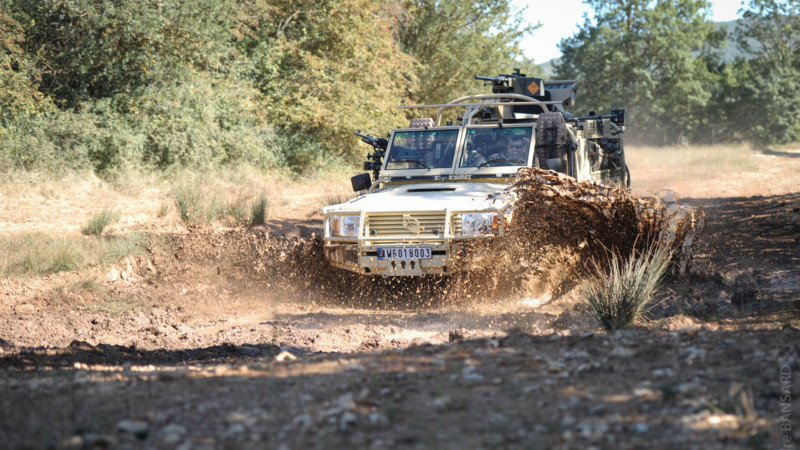Land
Easy EV: Challenges and benefits of land vehicle electrification
Switching to electric battery-powered or hybrid land vehicles offers many advantages, including reducing reliance on fossil fuels, silent operation and often greater torque and improved off-road performance. However, these benefits come at a price and with technical hurdles to overcome. Norbert Neumann investigates the current status of electric land vehicle concepts in the UK and US.
Transforming military ground vehicles to fully electric power any time soon seems too ambitious to most experts, but there are a few things to bear in mind before giving up on battery-powered solutions.
At the recent COP26 climate conference, most developed and several developing countries pledged to reach net-zero carbon gas emissions by 2050. Making the way militaries roll more sustainable would be an important contribution to that goal.
Using electric, or hybrid of fossil fuel and electric, propulsion can not only benefit the planet but can also enhance operational capabilities. Deploying modern technology helps militaries gain and retain operational advantage over adversaries. It also offers military vehicle manufacturers a market advantage.
After speaking at the US Army’s Ground Vehicle System Center in Detroit in November, US Deputy Secretary of Defense Dr Kathleen Hicks said that fleets of electrified vehicles are capable of carrying some of the military’s workload while cutting harmful emissions. Similarly, the British Army announced that it is moving towards the electrification of battlefield vehicles at the Defence and Security Equipment International exhibition (DSEI) 2021 in London in September.
US efforts
British protection system expert Jankel and US-based Williams Advanced Engineering (WAE) are collaborating to bring electric vehicle (EV) technologies and capabilities to the US defence market. WAE is an engineering service provider, with experience in electrification, ‘light-weighting’, batteries and control systems.
Hybridisation projects are likely to start on the smaller side
The partnership is led by Jankel, which has a track record of designing, manufacturing and delivering vehicle-related technology. It has integrated its solutions in numerous US departments, including the Department of Defence. The partners say they will combine complementary technologies and capabilities to advance military hybrid and electrification projects, regardless of size.
But electrifying large, armoured vehicles and battle tanks comes with enormous challenges. With current battery technology, deploying an electric 27t M2 Bradley fighting vehicle, for instance, is not a viable option due to range limitations. Increase the number of batteries in the vehicle and it quickly becomes too heavy to carry enough armour, equipment and personnel. But a diesel-electric hybrid solution might alleviate some part of the range problem.
Jankel-WAE partnership spokesperson Gareth Baker says: “Hybridisation projects are likely to start on the smaller side. We see opportunities in the whole fleet staged over the next 20 years or more, starting on the smaller side and gradually getting bigger as the technology matures.”
Baker adds that battery technology with the right level of durability and charging rate, air transportability and having an adequate infrastructure to support EVs are all essential areas that need improving if hybridisation and electrification are to become reality on a large scale.

// WAE and Jankel are partnering to bring EV technologies to the US defence market. Credit. Jankel
UK electric developments
The UK Ministry of Defence’s (MOD) knows that keeping pace with technology is challenging but vital to retain competitive advantage on the battlefield. Its trading entity, Defence, Equipment & Support (DE&S), recently launched its 2025 strategy aiming to do just that.
Considering the MOD’s Climate Change and Sustainability Approach review, the agency is tasked to modernise defence while also meeting environmental targets. An MOD spokesperson said in a statement that the electrification and hybridisation of the battlefield will not only help the UK meet those goals but will also increase operational advantage and change the way land forces operate in the future.
Electric vehicles can enable more effective stealth mode capabilities as running on batteries significantly reduce thermal and noise signature. Improving electrification capabilities on land can also mean a step towards achieving autonomous or semi-autonomous operations and increased situational awareness through improved sensors.
The British Army announced its battlefield electrification approach under the Future Soldier project at DSEI 2021 in September. One of its focuses is deploying electric batteries, sustainable energy and hybrid electric drive technologies across its entire vehicle fleet.
The MOD spokesperson said that hybrid technologies that may offer technical and operational enhancements to military vehicles whilst reducing reliance on fossil fuel are currently being tested by the British Army.
Experimental prototypes of hybrid vehicles include the General Dynamics Foxhound Ocelot, the Supacat Jackal high-mobility carrier and the Maschinenfabrik Augsburg-Nürnberg(commonly known as MAN) support vehicle. The performance of the vehicles is evaluated by the DE&S under a £9m programme.
Assistant head of plans for the British Army ground manoeuvre capability Colonel Simon Ridgway OBE says: “The army's approach to electrification will set out how the army intends to take advantage of the opportunities provided by sustainable technology for land capabilities.
“It will ensure the army’s electrical infrastructure is ready to meet the electrical demand required on the battlefield of the future. Delivering effect needs the right power, in the right place, at the right time. Using hybrid vehicles will make it easier to get the power to where it needs to be.”

// Jankel Fox long-range patrol vehicle. Credit: Jankel
An icon electrified
In 1989, the first high-mobility multipurpose wheeled vehicle (HMMWV or Humvee) rolled on the battlefield with the US as part of Operation Just Cause, the invasion of Panama. It was designed to transport US troops around the battlefield, but other vehicles have taken its place in modern combat due to the Humvee’s inadequate survivability.
Despite numerous upgrades over the years, many think that the Humvee is nearing the end of service and more capable solutions like the Oshkosh Defence-produced joint light tactical vehicle is set to overtake.
Interestingly, Humvee’s manufacturer AM General and British defence company QinetiQ entered into a strategic collaboration to support the development of electrification technologies of military vehicles. The partners chose the Humvee to demonstrate the viability of a hybrid electric military land vehicle concept.
The companies have created two fully interactive and immersive virtual reality models of the Humvee to model the integration of QinetiQ’s electric drive technology.
The partners said in a statement: “The two different models can be individually adapted and then compared side by side to immediately see the impact of the changes made.
“The motors draw power via cables from a battery which can be positioned almost anywhere within the vehicle to give ultimate flexibility over the use of space. The hybrid electric drive system will enable the vehicles to tackle more hostile terrains while increasing lethality by giving it the ability to conduct extended periods of silent watch and silent running.”

// CB90 can achieve speeds of 40 knots. Credit: Saab
// Main image: The iconic Humvee is being used to demonstrate the viability of a hybrid electric military land vehicle concept. Credit: Credit. AM General Flickr